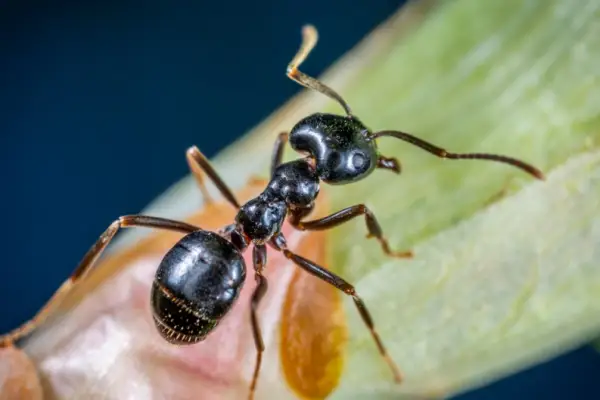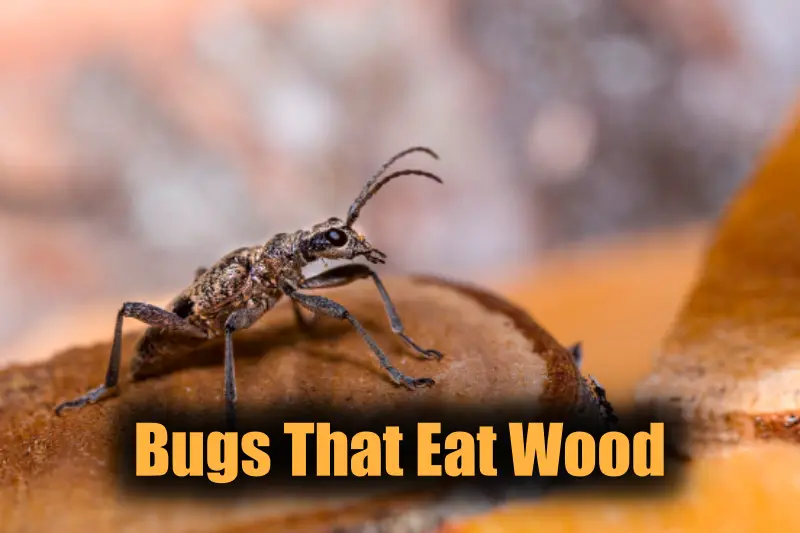During the rainy season or shortly thereafter, you must have seen several bugs in your furniture or on a nearby tree. If you think I’m talking about termites only, then you are wrong.
There are a lot of bugs that eat wood or damage it. In this article, we will discuss bugs that eat wood and their adaptations. Here is a list of 10 bugs that eat wood, so let’s get started.
10 Bugs That Eat Wood/Lumber
1. Termite
See how Termites damage wood
- Infraorder: Isoptera
- Size: 3mm to 1 inch long
- Identification: White to light brown in color with two straight antennae
When you think of bugs that eat wood, termites are the first ones that come to mind. Termites are known to harm buildings and residences, in addition to furnishings.
This creature has the ability to feed on wood. They are adapted in such a way that the mouthparts can chew or break cellulose.
Unlike other insects, they don’t have resting periods; they continuously feed around the clock, which causes more damage to the wood.
2. Carpenter Ant

- Scientific name: Camponotus spp.
- Size: up to 1 inch long
- Identification: Have rounded thorax and bent antennae
Meet these tiny carpenters who love wood. Carpenter ants are large ants with an average size of 4 to 20 mm.
They usually don’t consume wood but excavate galleries and tunnels in the wood, creating nests.
You can mostly find them in moist areas like around and under windows, roof eaves, decks, and porches.
They are considered both predators and scavengers. Their main sources of food are insects, nectar, and the honeydew that aphids create.
3. Powderpost Beetle
- Subfamily: Lyctinae
- Size: 1/16-1/4 inch
- Identification: Reddish brown in color with tube-shaped body and clubbed antennae
As the name indicates, these Powderpost beetles have the ability to reduce wood into a powder-like substance. These small, cylindrical brown beetles generally attack hardwoods, which are used to make furniture and flooring.
They perforate the wood with numerous holes. These holes are often used by the adults of this species to deposit their eggs, and the larvae that emerge from those eggs feed on wood to build tunnels or burrows.
These beetles are drawn to warm, damp areas, and wood chips or obvious exit holes close to the infected region are frequently signs of their presence.
4. Old House Borer
- Scientific name: Hylotrupes bajulus
- Size: 8–20 mm
- Identification: Brown to black in color with fine gray furriness and two shiny black bumps behind their head
The Old House Borer, Longhorn Beetle, European House Borer, and Italian Beetle are some of the common names by which people know about Hylotrupes bajulus.
These woodboring beetles are known to feed mainly on softwood timber like pine. Unlike their name, their larvae prefer new woods as they have a higher resin content than older woods.
Africa, South America, Asia, and Australia are the regions where these are most prevalent.
5. Deathwatch beetle
- Scientific name: Xestobium rufovillosum
- Size: 6 to 7.5 mm (0.24 to 0.30 in)
- Identification: Have cylindrical, hairy brown body
Let’s start with an interesting fact about these Deathwatch beetles. They are called so because people used to believe that the tapping sound they made was an omen of impending death.
But these sounds are made by males to attract their potential mates.
They are the longest-living beetle species, with larvae that may survive for up to 30 years and are far more hazardous than adults.
Their larvae bore into tunnels and come out at the time of pupating.
6. Carpenter Bee

- Scientific name: Xylocopa
- Size: 2 mm to 4 cm
- Identification: All shiny black with yellow, and orange thorax
The next bug we’ll talk about is the carpenter bee. Their nesting behavior is something unique, due to which they got their name, carpenter bees.
Usually, they burrow under hardwoods like bamboo or dead wood. Carpenter bees, in contrast to bumblebees, have a glossy, hairless abdomen.
In the wood tunnel, females lay their eggs, or the larvae reside there and eat nectar and pollen.
Males of these species are more concerned with defending their territory and nests.
7. Furniture Beetle
- Scientific name: Anobium punctatum
- Size: 2.7–4.5 millimeters
- Identification: Have a long, brown pill-shaped body
You can easily identify them by their long, pill-shaped, hairy bodies. Adults of these species don’t usually eat.
The wood has tiny holes produced by larvae that are invisible to the unaided eye.
They bore into wood to feed, which is considered the most destructive phase. Frass, or little heaps of wood dust, are the hallmark of woodworm destruction.
They usually attack the seasoned sapwood, and their nuisance can be controlled by using insecticides like permethrin or by replacing wood.
8. Horntail Wasp

- Family: Siricidae
- Size: up to 3.75 cm (about 1.5 inches)
- Identification: Have two spine-like projections at the tip of their abdomen
Ever imagined a wasp with two big horns? Observe this horntail wasp, which is distinguished by two sizable protuberances or a structure like a spine on its abdomen that mimics horns.
These wasps are known to cause damage to trees and also contribute to the decomposition of dead and decaying trees.
Like other wasps, they don’t sting and are considered harmless.
9. Goat Moth
- Scientific name: Cossus cossus
- Size (Wingspan): 70-100 mm
- Identification: Have grayish brown wings with fine dark lines
You can spot these moths in Asia, Europe, and Northern Africa, inhabiting woodlands, hedgerows, parks, and gardens.
Their larvae are 9 to 10 cm in length with red or purplish stripes across the back, and they are known to bore excavate tunnels as they feed, which damages the trees to a very large extent.
Goat moths get their name from the fact that both their larvae and adults have a goat-like stench.
10. Bark Beetle
- Subfamily: Scolytinae
- Size: around 1/8 of an inch
- Identification: Small in size with short or knobbed antennae and large mandibles
Bark beetles are the species of beetles that feed on the inner bark (phloem) of trees.
They are crucial to the breakdown of dead or rotting trees, but if they are present in high quantities, they may cause issues.
A symbiotic relationship is also seen with certain fungi.
These beetles spread the fungal spores all along the tunnels they made in the trees, leading to the formation of a fungal garden on which these beetles feed.
Conclusion
Here we conclude our article on bugs that eat wood. These wood-eating insects are typically regarded as domestic pests.
There are a lot of ways to control the invasion of these bugs, either with insecticide or by replacing the wood.
I hope reading about these fascinating bugs is enjoyable for you. Enjoy this until we return shortly with another story.
Also Read:

Being a zoology student I’m always been fascinated toward animals especially insects. I love to do research and learn about different animals. As a writer I want to share my thoughts about nature through my articles. Apart from this you can find me exploring the new places and voice notes.
